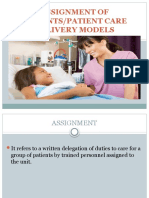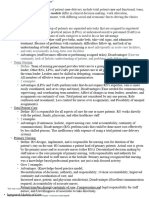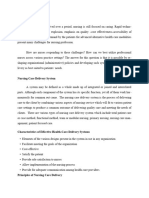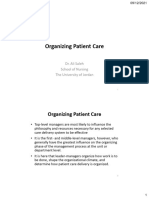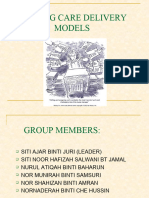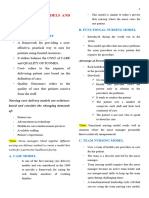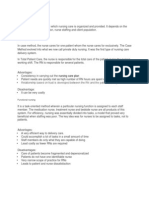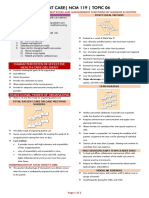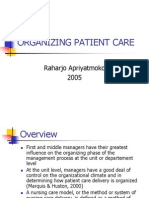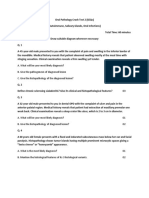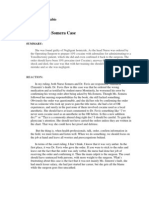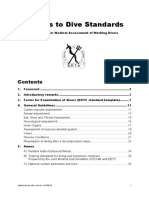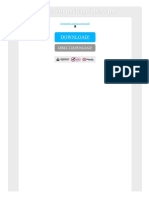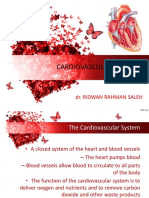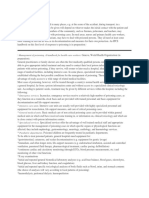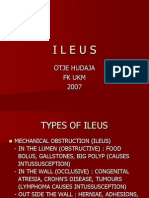NUR 2440: Fundamentals of Adult Health Nursing Bridget Apple, BSN 93013
�Objectives: Differentiate among the types of nursing care delivery models. Describe the elements of decentralized decision making. Discuss ways in which a nurse manager supports staff involvement in a decentralized decisionmaking model.
2
�Entry-Level Nurse Competencies:
System focus Understanding of the environment of care Managing patient care Critical thinking Interdisciplinary communication Patient focused care Respect of patient rights, beliefs, wishes and values Advocacy Recognition of limitations and willingness to seek help Knowledge of the roles, responsibilities and functions of a nurse
3
�Nurse Executive
Who Are They?
Vice President or Director of
What Is Their Role?
Unites the strategic direction
Nursing
with the philosophical values and goals of the organization
Clinical & Business Leader
maintaining quality and costeffectiveness
Creates a philosophy of nursing
that enables managers and staff to excel in better quality care and organization support.
4
�An Effective Leader is
Effective communicator Caring, understanding,
Consistent
Knowledgeable and
competent Role model Values participation Appropriate delegation Sets objectives and guides staff
and empathetic Motivational Proactive and flexible
Potter, P., Perry, A.G., Stockert, P.A., & Hall, A.M. (Eds.). (2013). Fundamentals of nursing. St.Louis, MO: Mosby
5
�Nursing Care Delivery Models
Nursing Models Team Nursing Characteristics
Team leader = RN Care directed by team leader; provided by team Team leader develops plans of care & coordinates care Hierarchical communication
Advantages
Collaborative Autonomy for team leader Decisions made at clinical level Nursing care conferences PCM able to manage unit issue High patient satisfaction RN plans care High amount of interdisciplinary collaboration Flexible Autonomous Collaborative Continuity of care Reduced errors
Disadvantages
RN is not as directly visible to patients Delegation takes time
Total Patient Care
All patient care done by RN Delegation allowed Direct work with patient/family/ interdisciplinary team RN responsible for caseload of patients Continuity of care providers RN assesses, develops POC, & provides interventions Lateral communication
Low continuity of care possible Decreased cost effectiveness
Primary Nursing
Plan of care changes must be validated with primary RN Not cost saving
6
�Nursing Care Delivery Models
Nursing Models Team Nursing Characteristics
Team leader = RN = RN Team leader Care directed by team leader; provided by team All patient careby Care directed Team leader develops plans RN responsible for done by RN of care & coordinates care team leader; caseload Hierarchical of provided by team patients communication
Advantages
Collaborative Collaborative
Disadvantages
Total Patient Care
Primary Nursing
RNis is not asas directly RN not Autonomy for team visible to patients directly visible to leader Delegation takes time patient Low continuity High Autonomy for patients made at Decisions Flexible Plan of care satisfaction of care possible clinical level team leader changes must Nursing care takes conferences Autonomous Delegation be validated Delegation plans cost RN Decisions time PCM able tocare manage Decreased with primary allowed effectiveness unit issue Team leader made at Continuity of care Collaborative RN High amount All patient care done by RN High patient Low continuity of care develops plans of clinical level providers Delegation allowed satisfaction possible Direct work with of intercare & Continuity Decreased Not cost saving Direct work with RN plans care of cost patient/family/ disciplinary coordinates care High amount of effectiveness patient/family/ RN assesses, care Nursing care interdisciplinary collaboration interdisciplinary team interdisciplinary conferences develops POC, & collaboration team provides Hierarchical Reduced errors Plan of care changes RN responsible for caseload Flexible communication PCM able to interventions of patients Autonomous must be validated with manage unit Continuity of care providers Collaborative primary RN RN assesses, develops POC, Continuity of care Not cost saving issue & Lateral provides interventions Reduced errors communication Lateral communication
7
�Case Management
a collaborative process of assessment, planning,
facilitation, and advocacy for options and services to meet an individuals health needs through communication and available resources to promote quality cost-effective outcomes. (Case Management Society of America, 2010)
�Decision Making
Decentralized management Decisions are made at the level of the staff All are included in the process of creating the best patient care available Greater collaboration Increased staff competency Increased staff motivation Increased staff satisfaction
�Definitions:
Responsibility
Reflects ownership. These are the activities one is expected to perform Freedom of choice and the responsibility of the choices made. Power to direct others and make final decisions. Answerable to the actions taken.
10
Autonomy
Authority
Accountability
�1. Shared Governance
2. Nurse/Physician Collaborative Practice 3. Interdisciplinary Collaboration 4. Staff Communication 5. Staff Education
11
�1. Task
2. Circumstances 3. Person 4. Direction/Communication 5. Supervision/Evaluation
12
�Delegation Assessment
Assess
Match Communicate Listen
Do they understand? Do they have questions?
Feedback
Knowledge and skills of the delegate
Match the delegate to the skill
Communic ate clearly
Listen after instructions
Regardless of the outcome.
Was there miscommunication How could things have been done better?
13
�Testing Our Knowledge:
1. The type of care management approach that
coordinates and links health care services to patients and their families while streamlining costs and maintaining quality is:
Primary nursing B. Total patient care C. Functional nursing D. Case management
A.
14
�Testing Our Knowledge:
1. The type of care management approach that
coordinates and links health care services to patients and their families while streamlining costs and maintaining quality is:
Primary nursing B. Total patient care C. Functional nursing D. Case management
A.
15
�2. Which example demonstrates the nurse performing the skill
of evaluations?
A. B. C. D.
The nurse explains that side effects of the new blood pressure medication ordered for the patient. The nurse asks the patient to rate pain on a scale of 0 to 10 before administering the pain medication. After completing the teaching, the nurse observes the patient draw up and administer an insulin injection The nurse change the patient's leg ulcer dressing using aseptic technique.
16
�2. Which example demonstrates the nurse performing the skill
of evaluations?
A. B. C. D.
The nurse explains that side effects of the new blood pressure medication ordered for the patient. The nurse asks the patient to rate pain on a scale of 0 to 10 before administering the pain medication. After completing the teaching, the nurse observes the patient draw up and administer an insulin injection The nurse change the patient's leg ulcer dressing using aseptic technique.
17
�Objectives: Describe the five levels of communication and their uses in nursing (1) List nursing focus areas within the four phases of a nurse-client helping relationship. (1, 2, 4) Discuss and demonstrate effective communication techniques for clients at various developmental levels. (4, 7, 8)
18
�19
�Levels of Communication:
Intrapersonal
Interpersonal Transpersonal
Small-group
Public
20
�Communication Process and Elements
21
�Forms of Communication
22
�Phases of the Helping Relationship
Preinteraction Phase
23
�Preinteraction Phase
Orientation Phase
24
�Preinteraction Phase
Orientation Phase
Working Phase
25
�Preinteraction Phase
Orientation Phase
Working Phase
Termination Phase
26
�Professional Communication
Courtesy
Use of Names Trustworthiness
Autonomy and Responsibility
Assertiveness
27
�Communication Consideration Requiring Special Needs
Patients with Speech Difficulties (Aphasia,
Dysarthria, Muteness)
Listen attentively/patiently/avoid interruptions Avoid open ended questionsYes/No when possible Allow appropriate time Consult speech therapy Communication aids
28
�Communication Consideration Requiring Special Needs
Cognitive Impairment Patients with Speech Difficulties (Aphasia, Dysarthria, Muteness) Simple/short sentences Listen attentively/patiently/avoid interruptions One question at a time Avoid open ended questionsYes/No when possible Attention Allow appropriate time Include family & friends Consult speech therapy Communication aids
29
�Communication Consideration Requiring Special Needs
Hearing Impaired Check for assistive devices Reduce background noise Eye contact when speaking Normal voice volume Signer if needed
30
�Communication Consideration Requiring Special Needs
Visual Impaired Hearing Impaired Check for assistive devices Check for assistive devices Identify presesence Reduceyour background noise Normal voicewhen volume Eye contact speaking Indirect Normallighting voice volume 14-point print Signer if needed
31
�Communication Consideration Requiring Special Needs
Unresponsive Visual Impaired Address patient by devices name Check for assistive Use touch and verbal communication Identify your presence Assume that the patient can hear/feel everything Normal voice volume
Explainlighting what your doing, why your doing it Indirect Person, place, time orientation 14-oint print Avoid all conversations that assume the patient is not present
32
�Communication Consideration Requiring Special Needs
Speaking Non-English Unresponsive normal tone by and voice volume Use Address patient name interpreter avoid family/friends Use Useprofessional touch and verbal communication Communication Assume that theboard patient can hear/feel everything Explain a what your doing, why your it help (call light Establish method for patient to doing ask for Person, place, time orientation etc)
Avoid all conversations that assume the patient is not present
33
�Communication Consideration Requiring Special Needs
Non-English Speaking Use normal tone and voice volume Use professional interpreteravoid family/friends Communication board Establish a method for patient to ask for help (call light etc)
34
�Testing Our Knowledge:
1. The nurse summarizes the conversation with
the patient to determine if the patient has understood him or her. This is what element of the communication process?
Referent B. Channel C. Environment D. Feedback
A.
35
�Testing Our Knowledge:
1. The nurse summarizes the conversation with
the patient to determine if the patient has understood him or her. This is what element of the communication process?
Referent B. Channel C. Environment D. Feedback
A.
36
�Testing Our Knowledge:
2. You are caring for Mr. Smith, who is facing
amputation of his leg. During the orientation phase of the relationship, what would you do?
Summarize what you have talked about in the previous sessions B. Review his medical record and talk to the other nurses about how he is reacting C. Explore his feelings about losing his leg D. Talk with him about his favorite hobbies
A.
37
�Testing Our Knowledge:
2. You are caring for Mr. Smith, who is facing
amputation of his leg. During the orientation phase of the relationship, what would you do?
Summarize what you have talked about in the previous sessions B. Review his medical record and talk to the other nurses about how he is reacting C. Explore his feelings about losing his leg D. Talk with him about his favorite hobbies
A.
38
�Testing Our Knowledge:
3. What sociocultural characteristics of nonverbal communication can impede communication?
Face to face communication B. Eye contact, touch, and body language C. Social distance and territoriality D. Attitudes of respect, trust, and caring
A.
39
�Testing Our Knowledge:
3. What sociocultural characteristics of nonverbal communication can impede communication?
Face to face communication B. Eye contact, touch, and body language C. Social distance and territoriality D. Attitudes of respect, trust, and caring
A.
40
�Objectives: Describe methods of interdisciplinary communication. Identify the purposes of the healthcare record and the legal guidelines associated with it. Discuss record keeping in healthcare and quality relates. Discuss the various forms of report; what is included and when they should be utilized.
41
�The Connection between Communication and Documentation:
Patient has chest pain if she lies on He expired on the floor
her left side for over a year.
uneventfully.
On the second day the knee was
better and on the third day it had completely disappeared.
She slipped on the ice and
apparently her legs went separate directions in Chicago.
Discharge status: Alive without
permission
suicide.
The patient had waffles for
breakfast and anorexia for lunch.
be able to get this lady pregnant.
42
The patient has no past histories of Between me and you, we ought to
�Written or printed information that is recorded accurately, timely, and effectively to validate that an action attempted and the result.
43
�Quality Documentation Components
Factual
Accurate Complete Current Organized
44
�Common Documentation Forms
Admission nursing history forms
Flow sheets and graphic records Patient care summary/Kardex
Standardized care plans
Discharge summary Acuity records
45
�Legal Standards of Documentation
Guidelines
Fact filled Black ink Chart only for as or for
Rationale
Only objective/factual
yourself Avoid empty spaces Start: Date/Time. Real time End: Your name and title
observations and patient quotes. Black ink is easiest to read and copy You are accountable for whatever you chart Avoid others charting within your charting Provides sequencing Accountability
46
�SBAR Reporting Situation Background Assessment Recommendation
47
�Scenario
Mr. Tree is a healthy 22 year old landscaper, with no
medical or previous surgical history, who fell 4 feet from a ladder two days ago, fracturing his right ankle. Mr. Trees has no medical allergies. Mr. Tree underwent surgical repair for his ankle and was transferred to your general medical/surgical nursing floor. Dr. Fix orders vital signs for every 8 hours with circulatory checks; activity orders are to transfer with one assist; saline IV flushed every 8 hours; Tylenol with codeine 500mg tablets, 2 tablets PO prn pain. The patient care assistant comes to you and says, Mr. Tree in room 3 is refusing to get out of bed because his ankle hurts him too much.
48
�Scenario Cont.
When you enter Mr. Trees room you note that he is
sitting ridged in bed with his eyes closed. When asked about pain Mr. Tree reports that his is currently having 9/10 sharp pain from his ankle to half way up his calf. As the primary nurse you begin to assess Mr. Trees leg. It is noted that Mr.Trees leg has no increased swelling, skin color is pink, warm and dry and has a <3 second capillary refill. Looking in Mr. Trees chart, you note that his last tylenol was taken 4 hours ago. Mr. Tree asks you, Cant I get something stronger? The tylenol is just not strong enough.
49
�Nursing Informatics
Science that integrates the sciences of nursing,
computers and information to manage and communicate data, information, and knowledge in nursing practice (American Nurses Association, 2008).
50
�Health Care Information System (HIS)
Clinical Information Administrative
System (CIS)
Nursing Information
Information System
System Laboratory Information System Radiology Information System
51
�Nursing Clinical Decision Support Systems (NCDSS)
Computerized programs
that support healthcare. rules and if___then statements Current Evidence based Updateable
52
�Security
Computerized charting increases security risks,
confidentiality risks, and privacy risks. Health Insurance Portability and Accountability Act (HIPPA) Personal Health Information (PHI) Proper disposal and protection of health information
53
�Computerized Provider Order Entry (CPOE)
Healthcare providers use these systems to directly
order. Reminders Alerts
54
�Testing Our Knowledge
1.
A patient asks for a copy of her medical record. The best response by the nurse is to:
State that only her family may read the record. B. Indicate that she has the right to read her record. C. Tell her that she is not allowed to read her record. D. Explain that only health are workers have access to her record.
A.
55
�Testing Our Knowledge
1.
A patient asks for a copy of her medical record. The best response by the nurse is to:
State that only her family may read the record. B. Indicate that she has the right to read her record. C. Tell her that she is not allowed to read her record. D. Explain that only health are workers have access to her record.
A.
56
�Testing our Knowledge
2. On the nursing unit you are able to access a patients
medical record and review the education that other nurses provided to the patient during an initial hospitalization and three subsequent clinic visits. This type of feature is most common in what type of record system?
Information technology B. Electronic health record C. Personal health information D. Administrative information system
A.
57
�Testing our Knowledge
2. On the nursing unit you are able to access a patients
medical record and review the education that other nurses provided to the patient during an initial hospitalization and three subsequent clinic visits. This type of feature is most common in what type of record system?
Information technology B. Electronic health record C. Personal health information D. Administrative information system
A.
58
�Testing Our Knowledge
3. What is an appropriate way for a nurse to dispose of
printed patient information?
Rip several times and place in a standard trash can B. Place in the patients paper-based chart C. Place in a secure canister marked for shredding D. Burn the documents
A.
59
�Testing Our Knowledge
3. What is an appropriate way for a nurse to dispose of
printed patient information?
Rip several times and place in a standard trash can B. Place in the patients paper-based chart C. Place in a secure canister marked for shredding D. Burn the documents
A.
60
�61


